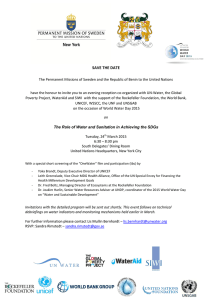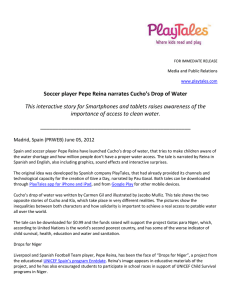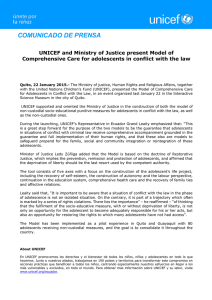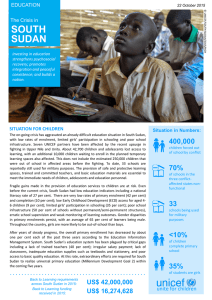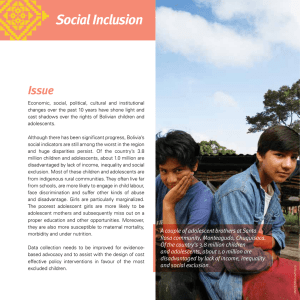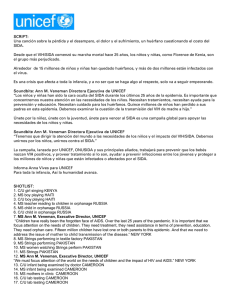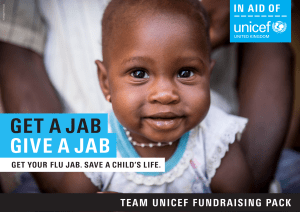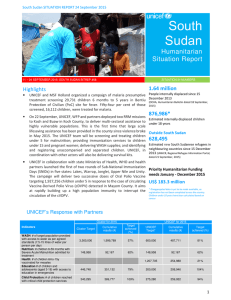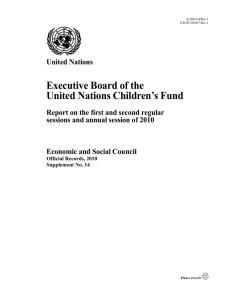Integrated Social Protection Systems: Enhancing Equity for Children
Anuncio
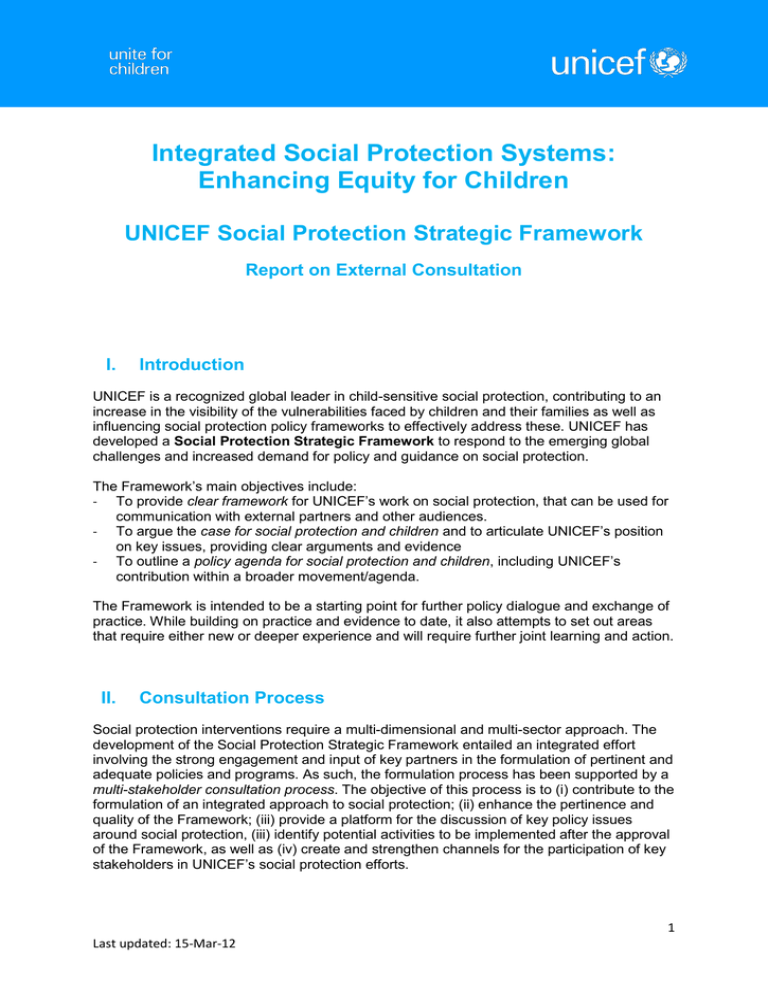
Integrated Social Protection Systems: Enhancing Equity for Children UNICEF Social Protection Strategic Framework Report on External Consultation I. Introduction UNICEF is a recognized global leader in child-sensitive social protection, contributing to an increase in the visibility of the vulnerabilities faced by children and their families as well as influencing social protection policy frameworks to effectively address these. UNICEF has developed a Social Protection Strategic Framework to respond to the emerging global challenges and increased demand for policy and guidance on social protection. The Framework’s main objectives include: - To provide clear framework for UNICEF’s work on social protection, that can be used for communication with external partners and other audiences. - To argue the case for social protection and children and to articulate UNICEF’s position on key issues, providing clear arguments and evidence - To outline a policy agenda for social protection and children, including UNICEF’s contribution within a broader movement/agenda. The Framework is intended to be a starting point for further policy dialogue and exchange of practice. While building on practice and evidence to date, it also attempts to set out areas that require either new or deeper experience and will require further joint learning and action. II. Consultation Process Social protection interventions require a multi-dimensional and multi-sector approach. The development of the Social Protection Strategic Framework entailed an integrated effort involving the strong engagement and input of key partners in the formulation of pertinent and adequate policies and programs. As such, the formulation process has been supported by a multi-stakeholder consultation process. The objective of this process is to (i) contribute to the formulation of an integrated approach to social protection; (ii) enhance the pertinence and quality of the Framework; (iii) provide a platform for the discussion of key policy issues around social protection, (iii) identify potential activities to be implemented after the approval of the Framework, as well as (iv) create and strengthen channels for the participation of key stakeholders in UNICEF’s social protection efforts. 1 Last updated: 15-Mar-12 The Social Protection Strategic Framework is being consulted internally and externally. This report summarizes the comments and inputs received at the external consultation phase, as well as how these have been incorporated into the final draft. The external consultation phase involves strategic external partners at global and regional level. The main objective is the gather inputs and feedback, as well as discuss potential partnerships, value added and call for action in a broader social protection framework. A broader set of external actors, including governments and civil society (local) organization will be reached in the roll-out process of the Framework, once approved. The external consultation included the following activities: - - Concept note: Key message and Road Ahead (“Call for Action”): webinar-based and meeting discussions with strategic partners were convened to get initial input and feedback on the Framework’s main messages, as well to discuss UNICEF’s value added, key social protection policy issues (global agenda), and potential joint collaboration. External website: Concept note and presentation (PPT) was posted in UNICEF’s external website, to facilitate comments from different actors and sectors. http://www.unicef.org/socialpolicy/index_60921.html During this phase, comments were delivered via written form (email) or provided during the webinar-based consultation and meeting discussions. Consultation Questions includes: • • • • What are the key policy priorities for social protection? What should be UNICEF’s contribution to the global social protection agenda? In what key areas should UNICEF be engaging, including with partners? What issues/areas should we prioritize in the Road Ahead? What is your opinion of the proposed approach, principles and challenges? • Integrated Social Protection Systems • Progressive Realization of Universal Coverage • National Ownership and Context Specificity • Inclusive Social Protection Invited Participants/Organizations Table I includes actors involved in the external consultation process through webinar-based discussions and/or face-to-face meetings. UN-Partners Bilaterals Multilateral Agencies Organization United National development Programme (UNDP) World Health Organization (WHO) International Labour Organization (ILO) International Monetary Fund (IMF) World Food Programme (WFP) Joint United Nations Programme on HIV/AIDS (UNAIDS) Department for International Development-UK (Dfid) US Agency for International Development (USAID) European Commission, Development Cooperation Directorate World Bank 2 Last updated: 15-Mar-12 Research / Academic International NGOs Inter-American Development Bank Asian Development Bank African Development Bank Institute for Development Studies (IDS) Oversees Development Institute (ODI) Oxford Policy Management (OPM) Young Lives-Oxford University Economic Policy Research Institute(EPRI) Save the Children-UK Help Age International Oxfam-UK Timeline: The External consultation process was implemented from November 2011January 2012. III. Summary of Inputs and Comments: Phase 1 The comments received during the External Consultation phase helped to enhance the Framework’s approach, as well as strengthen linkages with the broader social protection agenda. Among the general themes we can include: - Broad consensus on the importance and relevance of promoting integrated systems Strong support for UNICEF’s efforts and leadership in promoting economic as well as social vulnerabilities as part of its definition and approach. Areas considered and integrated include: - How to develop and/or prioritize interventions conducive to integrated and comprehensive systems in fiscally and budget-constrained contexts? - How does UNICEF’s approach to social protection links with productivity, labor market access and development, and economic growth? - What are the key lessons learned of UNICEF practice and how have these informed the Framework’s approach? Table II presents, a summary of key comments and inputs and how these have been integrated into the final draft document. 3 Last updated: 15-Mar-12 IV. Table II: Summary of External Comments Received and UNICEF Responses, by theme Comment Response General - Strong support towards the presentation and articulation of UNICEF’s position on social protection Broad consensus on the importance and relevance of promoting integrated systems Strong support for UNICEF’s efforts and leadership in promoting economic as well as social vulnerabilities as part of its definition and approach. Definition and components - Definition and components of social protection: Participants demonstrated strong support for UNICEF’s definition of social protection, and components, as well as to its focus and leadership in promoting a consideration of social vulnerabilities and encouraged the strengthening of the rationale behind this. Suggestions taken into consideration; the rationale was strengthened in the “Definition and Conceptual Framework” section, in Chapter III, and concept clarifications were made where necessary. More clarification as to the different instruments, are provided in Chapter IV. At the same time, participants suggested broadening the understanding of “shocks” mentioned in the definition to other, noneconomic shocks (life-cycle, health, climactic, etc.). Some proposed clarifying differences between “components,” “objectives,” and “types of instruments.” Other participants also suggested defining more clearly and explicitly the following instruments: social insurance, child benefits, and employment rights. There are some similarities between UNICEF’s Framework approach on integrated systems and the strategy adopted by the other agencies, including the WFP, World Bank, among others; thus, harmonization of concepts and terminology (ie: safety nets, coverage, access, integrated programs) would be valuable. In agreement that agencies need to work together in order to harmonize concepts. A follow-up meeting between UNICEF and the World Bank will be arranged. A glossary is also provided in the Framework. Integrated Social Protection Systems Several participants commented on the relevance and timeliness of In agreement. The Framework addresses the different stages at which 4 Last updated: 15-Mar-12 ‘integrated systems’ approach (including alignment with widely approaches supported by SPF, EU, G20 and others). General agreement that countries’ current practice and situation must be taken into account when proposing integrated systems and that there is a value to highlighting the role of social protection as part of on-going work – not simply as a response to crisis. - Multi-sector approach: Suggestion that Framework mentioned how social protection provides a foundation that supports investment in services (the two are complementary). At the same time, it was suggested that it be clarified that social protection is not the only approach for generating positive sector outcomes. countries are when considering integrated systems in the “Sequencing and Prioritization” section of Chapter VI. In the “Call for Action,” Chapter IX, the Framework discusses the relevance of social protection for addressing both structural determinants of vulnerability and increased volatility and crises. - Supply-side services: Some confusion existed as to why the Framework does not focus on the availability of services. UNICEF’s definition of social protection does not include supply-side investments. Social protection is seen as a set of policies and programs that contribute to increase households’ capacity to respond to risk, while ensuring access (determined by demand-side factors). However, sustainable social protection integrated systems imply the promotion of alongside supply side investments in order to achieve equitable outcomes. - Social protection providers – public and private: Participants suggested elaborating on how the complementarity of public and private social protection interventions can be ensured and how formal mechanisms can avoid jeopardizing informal solutions. A brief discussion of the role of non-state actors has been included. In agreement; the Framework argues these points when suggesting that an integrated approach is the best way to create synergies between these social protection and supply-side efforts. A discussion of how social protection should not be considered a silver bullet will be included in the section, “Multi-sectoral approach: Social protection as a tool for enhancing sector outcomes,” in Chapter V. Principles - Progressive realization of universal coverage: Strong support for UNICEF’s central treatment of this principle. Confusion as to what is meant by “universal coverage entails that social protection programmes and schemes are available to everyone according to need”: is this not paradoxical? In agreement; text has been revised to enhance clarity. - National leadership and context-specificity: Support towards recognition that social protection is primarily a core UNICEF’s approach is that interventions proposed are not determined by growth trends but responsive to contexts of vulnerability, whether 5 Last updated: 15-Mar-12 concern of partner governments, while acknowledging the potential rol of other actors. Questions as to whether a specific set of social protection interventions for all countries (regardless of growth and inequality context) can be defined. Additionally, participants suggested identifying some broad typologies and country models to better articulate the different implications of context specificity for policy and for the implementing agency’s involvement. these are economic, shock-related, or structural. Different contexts are discussed in the Framework, along with their respective social protection, technical assistance, and financing needs. Reference is made to other agencies’ typologies. - Inclusive Social Protection: Overall agreement that this section was important, valuable and helpful. Strong support towards UNICEF’s equity approach, and the need to focus the poorest, most marginalised and most vulnerable. Some participants suggested that the “inclusive design” table focus on other social protection components in addition to social transfers. Participants also mentioned that the tension between mainstreaming social inclusion and focusing on excluded groups may be worth highlighting. A balance between making social protection sensitive to excluded groups (HIV-, gender-sensitive, etc.) and making it focus on broader equity objectives needs to be struck. In agreement; The Framework recognizes the need to address common and shared causes/determinants of vulnerabilities rather than focus on specific groups when designing social protection policies. However, it also acknowledges the need to recognize and consider the added and specific vulnerabilities associated with the different dimensions of exclusion to effectively reach the most vulnerable. Table has been revised to integrate comments. Design and Implementation - Financing and fiscal space and growth: Widespread agreement that the Framework is valuable and clear, as well as timely given a fast-moving policy environment and the need for counter-cyclical responses to crises. Some participants suggested devoting a larger space to the topics of pro-poor growth and economic distribution, as well as couching the rationale for social protection in terms of its positive impacts on the economy. Additionally, some participants proposed making the point that social protection is often a transfer rather than a cost (GDP spending figures overestimate the cost if the transfer shows up elsewhere in the economy). In agreement. The Framework includes a section on financing; furthermore, a policy brief specifically on this topic is expected in 2012. Moreover, a discussion on growth and productivity has been included in the “Making the Case” section, in Chapter II. A suggestion was made that the Framework includes a section on 6 Last updated: 15-Mar-12 financing options and approaches. - Prioritization and sequencing: Questions as to how to promote a ‘systems’ approach under resource constraints and suggestion that, to address these contexts, guidance on how to prioritize and sequence programs might be included, as well as the possibility of considering a minimum set of outcomes for children. Some participants also suggested explicitly recognizing that cost constraints are linked with the politics of financing. A section on Sequencing and Prioritization has been included in Chapter VI, entitled, “Key Policy Issues & Challenges in the Implementation of Integrated Social Protection Systems.” The politics of financing are further discussed under Chapter VI’s section “Social protection financing.” - Type of Transfer: Suggestion that providing guidance on what type of social transfer is appropriate in a particular context would be useful. The Framework discusses key priorities in design and selection of interventions, including the role of vulnerability assessments, targeting methodologies and benefit size. - Social Safety Nets: Suggestion that UNICEF might serve as an advisor in contexts of fiscal constraint, helping identify which social safety nets are best for children. While UNICEF considers that social safety nets may be appropriate in a limited number of contexts (and works to ensure that they are childsensitive), it argues in the Framework that even where fiscal pressures exist, comprehensive systems may be the most appropriate approach. Issues are addressed in the section on Sequencing and Prioritization. - Graduation and exit strategies: Suggestion that these issues be added to the Framework with special care to include a discussion of policy makers expectations around graduation in order to prevent these issues from being linked to dependency arguments. A section on Graduation and Exit Strategies has been included in Chapter III, including UNICEF’s position and approach. - Conditionality: Participants characterized the summary of the conditionality debate that is provided in the Framework as “fair” and “very helpful.” They also commented that conditionality is only referred to in the narrowest of senses, when, in practice, most programs are conditional. Additionally, a participant suggested that two other issues related to conditionality be considered, namely: whether behaviour is at the core of the problem addressed by the intervention In agreement; suggestions will inform revisions. UNICEF has chosen to discuss conditionality as it is most commonly used by programs (mainly cash transfers). 7 Last updated: 15-Mar-12 and if political benefits/context may drive decisions to implement conditionality. - Targeting: There was strong support around the Framework’s position and discussion on universalism and progressive realization. They also cautioned that program design (not simply coverage) should be propoor. Some participants shared concerns that narrowly targeted programs may create animosity between groups. In agreement. The Framework recognizes the need to address common and shared causes/determinants of vulnerabilities rather than focus on specific groups when designing social protection policies (see: “Inclusive Social Protection” section). However, it also acknowledges the need to recognize and consider the added and specific vulnerabilities associated with the different dimensions of exclusion to effectively reach the most vulnerable. - Benefit size: Language around trade-offs between benefit size and unintended consequences, was considered helpful. Life-cycle approach: The importance of explicitly addressing the role of care givers was brought up, as well as the relevance of discussing the intrahousehold distribution of benefits not targeted at children. In agreement. Sections to highlight the role of caregivers, has been included in Chapter 1, section C (“Investing in children now, reaping long-term returns”) Emerging Issues - Urbanization: Participants found this section useful in light of the evidence on the rural bias of many existing social protection programmes. - Climate Change: Participants agreed that there was a strategic and practical need to frame social protection as a tool for Climate Change Adaptation. In agreement; Climate Change Adaptation has been included in Chapter VIII. UNICEF’s Role Strong support to UNICEF as leader in promoting addressing economic as well as social vulnerabilities in the context of children’s well-being In agreement. General agreement that UNICEF should continue playing a facilitating and convening role, as well as coordinating learning and knowledge sharing between partners and among countries, including 8 Last updated: 15-Mar-12 strengthening evidence and impact evaluation on impact of social protection on different outcomes. Suggestion that South-South learning may be an area of potential collaboration. Participants also recognized the need for UNICEF’s continued support in promoting the Social Protection Floor, especially given its strong presence in the field Collaboration A call for increased coordination between partners in preparation for key global advocacy events such as the G-20 and the Social Protection Floor Initiative was made while it was also recognized that UNICEF and a number of agencies have been working closely together with fruitful outcomes: ILO and UNICEF on the Social Protection Floor (where UNICEF’s strong field presence is an asset); and UNAIDS and UNICEF on HIV-sensitive social protection. It was also acknowledged that UNICEF’s Framework would serve to inform upcoming documents and strategies, such as USAID’s guidance document on OVC Programs. In agreement that more coordination prior to global advocacy events would be beneficial. Plans to continue collaboration with all agencies through different fora. This includes collaboration on the Social Protection Floor and partnership with UNAIDS and with the HIV/AIDS team in UNICEF with a view to launching a Joint Initiative on operational research in Eastern and Southern Africa in 2012. South-South collaboration: Questions emerged as to how to identify the most effective mechanisms, counterparts and proposals to collaborate with UNICEF on developing South-South learning opportunities? See “Call for Action” section in Chapter IX: “The Road Ahead.” In agreement regarding collaboration. Other - Lessons Learned: Suggestion that a “lessons learned” section, acknowledging process and historic interventions, be added. In agreement; section added. - Evidence: It was suggested that UNICEF’s role as developer of evidence on the impact of social protection could be strengthened. Equally, evidence on returns to investment were thought to be helpful. Participants suggested linking social protection to productivity and suggested closely monitoring the evidence emerging from LAC countries on the In agreement. UNICEF is expanding work in this area and has addressed returns to investment in the “Investing in Children” section of Chapter II. 9 Last updated: 15-Mar-12 impacts of social protection on inter-generational transmission of poverty and exclusion. Consultation Process Questions raised as to whether the Framework has been consulted on with national governments and counterparts Not explicitly. The Framework has been extensively discussed internally and shared with strategic external partners. The Framework’s concept note and presentation has been also posted in UNICEF’s external website for comments. However, given the strong field presence of UNICEF and the strong relationship between national offices and counterparts, we believe that key government priorities and issues have been reflected in the document based on inputs from regional consultation (internal) phase. Furthermore, the roll-out and dissemination phase will include discussions on how to adapt/adjust main approaches to regional and national contexts. 10 Last updated: 15-Mar-12 Participants Elliot Harris, Special Representative to the UN, International Monetary Fund Griet Cattaert, Social Security Officer - Focal Point Social Protection Floor, International Labour Organization Arup Banerji, Director, Social Protection and Labor, World Bank Laura Rawlings, Lead Social Protection, Specialist, Strategy and Results, Social Protection and Labor, World Bank Ugo Gentilini, Policy Officer, Policy, Planning and Strategy Division, World Food Programme Nicholas Taylor, European Commission- Development Cooperation Directorate Jason Wolfe, Senior Household Economic Strengthening Advisor, USAID Terhi Aaltonen, Technical Officer, Systems Integration, Department of Evidence, Strategy and Results, UNAIDS Claudia Vinay, Policy Specialist, United National Development Programme Tim Conway, Senior Poverty Advisor, Poverty and Vulnerability Team, Growth and Resilience Department, Dfid Jen Marshall, Lead Social Development Advisor, Dfid Mathew Greenslade, Economic Adviser, Poverty and Vulnerability Team, Dfid Heather Kindness, Social Protection Adviser, Poverty and Vulnerability Team, Growth and Resilience Department , Dfid Katie Chapman, Research Department, Dfid Mark Davies, Programme Manager for the Centre for Social Protection, Institute for Development Studies (IDS) Keetie Roelen, Research Fellow, Vulnerability and Poverty Reduction Team, Institute for Development Studies (IDS) Rachel Sabates-Wheeler, Research Fellow, Director for the Centre for Social Protection, Institute for Development Studies (IDS) Andrea McPherson, Social Protection Policy Officer, HelpAge International Bethan Emmett, Social Protection Advisor, HelpAge International Anna McCord, Research Fellow, Oversees Development Institute (ODI) Nicola Jones, Research Fellow, Oversees Development Institute (ODI) Paola Pereznieto, Research Fellow Oversees Development Institute (ODI) Alex Hurrell, Senior Consultant, Poverty and Social Protection, Oxford Policy Management (OPM) Alex Rees, Livelihoods Capacity Building Adviser, Save the Children-UK Paul Dornan, Senior Policy Officer, Young Lives (University of Oxford) Michael Samson, Director, Economic Policy Research Institute(EPRI) 11 Last updated: 15-Mar-12
